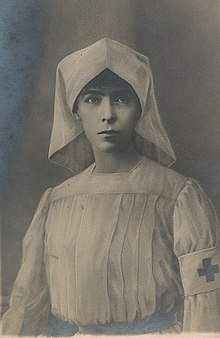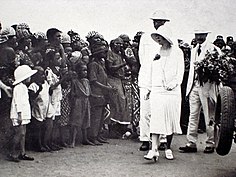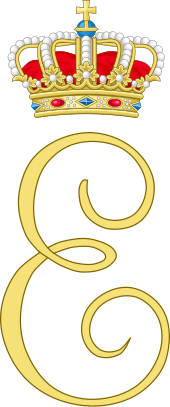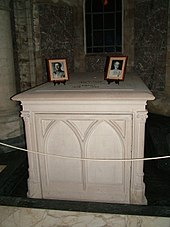Elisabeth Gabriele in Bavaria
Elisabeth Gabriele Valérie Marie Duchess in Bavaria (born July 25, 1876 in Possenhofen am Starnberger See , † November 23, 1965 in Brussels , Belgium ) was the wife of the Belgian King Albert I and the mother of the later Belgian King Leopold III. She also emerged as a patroness of music and the arts, as well as through her charitable activities. As Elisabethville , Lubumbashi carried her name until 1966. The Concours Musical Reine Elisabeth is also named after her.
Descent and youth
Elisabeth, born in 1876 in Possenhofen Castle , was a princess from the ducal branch of Zweibrücken - Birkenfeld - Gelnhausen of the Wittelsbach family . She was the second daughter of Carl Theodor Herzog in Bavaria and his wife, the Infanta Maria Josepha of Portugal . She was named after her aunt on her father's side, the Austrian Empress Elisabeth .
The princess and her siblings grew up very simply in Possenhofen Castle under the influence of her highly intellectual and charitable father, who had made a name for himself as a recognized ophthalmologist. Duke Carl Theodor allowed the personal development of his children a lot of space and impressed them with a feeling for their responsibility for the poor and the weak. He also cultivated the artistic taste of his family and promoted, for example, the musical interests of his daughter Elisabeth, who was particularly closely related to him, whereby she acquired a great skill in violin and piano playing. She should also show some skill in sculpture. In addition to German, she also spoke French and English. She worked in her father's hospital, studied nursing, and developed religious beliefs that conformed to the teaching of the Catholic Church.
Marriage and early years of marriage
Elisabeth met her future husband, Prince Albert of Belgium , who was one year her senior , in May 1897 at the funeral of her aunt Sophie , Duchess of Alençon, who had died in a fire in Paris . Albert, the second son of Prince Philipp, Count of Flanders , and his wife Maria Luise von Hohenzollern-Sigmaringen , was presumptive heir to the throne of Belgium, which was ruled by his unpopular uncle Leopold II . Subsequently, Elisabeth and Albert, who found each other very sympathetic, met again at Albert's sister Henriette , Duchess of Vendôme, and also with the Duke of Alençon and Elisabeth's aunt Marie , the former short-term queen of the two Sicilies. In September 1898, the two young people attended the funeral of the murdered Austrian Empress Elisabeth in Vienna . Their mutual affection had deepened. After their engagement in Neuilly-sur-Seine , the couple were also able to secure their love wedding on October 2, 1900 in the Frauenkirche in Munich .
A few days after their marriage, Elisabeth and Albert were enthusiastically received in Belgium and then went on their honeymoon in Italy. The 24-year-old princess then lived with her husband in the palace of her in-laws in the Rue de la Régence in Brussels, but then traveled to the Côte d'Azur with Albert in early 1901 to preserve a self-determined private life and stayed for a long time the following summer in her home town of Possenhofen. At the end of September 1901, she moved to the newly completed Hôtel d'Assche in Brussels.
From the marriage of the prince couple, which were considered very loving, three children emerged:
- Prince Leopold (born November 3, 1901, † September 25, 1983), Duke of Brabant , as Leopold III. King of the Belgians from 1934 to 1951
- Prince Karl (October 10, 1903 - June 1, 1983), Count of Flanders , Prince of Belgium
- Princess Marie-José (August 4, 1906 - January 27, 2001), Princess of Belgium, ⚭ 1930 King Umberto II of Italy
Elisabeth showed herself to be interested in the concerns of needy and sick Belgians, got to know the conditions in Brussels hospitals and orphanages and in particular promoted the fight against tuberculosis . Even before she came to power, she and her husband enjoyed great popularity among the people, also due to their modest and harmonious family life and their very egalitarian behavior at the time.
In the field of fine arts, Elisabeth paid particular attention to music. She played the violin for hours every day, with Eugène Ysaÿe as her teacher, and was an avid follower of Richard Wagner , but when she visited the Monnaie Theater she also attended operas by Georges Bizet , Claude Debussy and other French composers. She had been friends with the Belgian poet Émile Verhaeren since meeting on June 4, 1908 in Ostend . She also gave the Belgian painter Eugène Laermans the best possible medical treatment when he was in danger of going blind.
Belgian queen
After Leopold II died on December 17, 1909 after a 44-year reign, his nephew Albert swore the oath on the Belgian constitution six days later and was proclaimed Albert I as the new king. His wife Elisabeth thus became Queen of Belgium. After the swearing-in ceremony, numerous people enthusiastically celebrated the new ruling couple in Brussels. As a result, the government led it with a special focus on social responsibility. In November 1910, Elisabeth contracted severe pleurisy , which was not cured until February 1911.
Role in the First World War
When the First World War broke out , the Queen had to go through a spiritual conflict caused by the military conflict between her former fatherland and her people. As a result, she acted entirely in the interests of Belgium and broke off relations with her family in Bavaria. With her perfect knowledge of German, she had helped her husband on August 1, 1914, to write a personal letter to Kaiser Wilhelm II , in which Albert had asked, albeit in vain, to respect Belgian neutrality. Belgium then resisted the German invasion in August 1914. Elisabeth helped to ensure that wounded Belgian soldiers could be treated in the royal palace, which had been converted into a hospital. Only when German troops arrived in front of Brussels did they join the retreating Belgian armed forces. She took her three young children to safe England, at Hackwood House with British statesman Lord Curzon . In Antwerp she then met Winston Churchill .
On October 7, 1914, the king ordered his army to withdraw. The Belgians succeeded, among other things by flooding the Yser valley, to permanently assert a small part of their territory against the Germans. In the municipality of De Panne , located in this area on the Channel coast , not far from the front, Elisabeth and Albert lived for four years from their arrival on October 13, 1914. The Queen helped solve the urgent problem of arranging medical care for the many wounded. In collaboration with the surgeon Antoine Depage she sat in December 1914 in La Panne, a field hospital, the Hôpital de l'Océan, one whose operation they assumed the Belgian Red Cross and where they sometimes - the rapidly forming myth of infirmière Reine- by for countless hours, of course, caring for injured soldiers.
Elisabeth also founded the symphony orchestra of the Belgian army and provided the soldiers with warm clothes and shoes. To many Belgians she appeared to be the soul of resistance against foreign occupation. Writers and musicians such as Eugène Ysaÿe, Émile Verhaeren, Pierre Loti and Camille Saint-Saëns visited them in La Panne, as did the French President Raymond Poincaré . She took on delicate missions on behalf of her husband; and when she was frequently in England to meet her children, she researched the British Government's intentions for further waging the war. Albert used her family ties, such as the mediation of Hans Veit zu Toerring-Jettenbach , to initiate secret, but ultimately futile, peace negotiations with Germany.
In April 1918, Elisabeth informed Lord Curzon of her husband's decision to defy the major German offensive on the spot, and received assurance from the British leadership that their armed forces would continue to defend the Belgian coast and would not retreat behind the Somme . As the year progressed, the Allies gained the upper hand. After the withdrawal of the Germans and the end of the war, the royal couple with their sons Leopold and Karl made their acclaimed entry into Brussels on November 22, 1918, with the apparently overwhelmed Elisabeth riding a large white horse. Since the reconquest of the country had been very bloody, Elisabeth now tried u. a. to raise the financial means necessary for the continued operation of the numerous ambulances established during the war in occupied Belgium. She also maintained cooperation with the American Red Cross.
Life in the interwar period until Albert's death
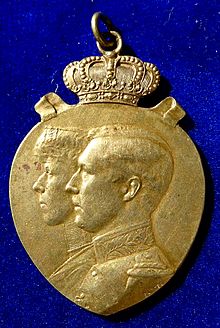
After the end of the First World War, many politicians paid an official visit to Brussels. Conversely, Elisabeth often went on trips abroad with Albert or alone. The Belgian couple made a state visit to the United States from September 23 to November 13, 1919, together with their eldest son, Crown Prince Leopold, met President Woodrow Wilson in the White House and toured the historic Isleta Pueblo in New Mexico . According to a role model she met on this tour, Elisabeth had a garden theater set up in Laeken Park . Almost every day Elisabeth practiced the violin again, which she has now mastered very well. For example, she played a violin duo with Yehudi Menuhin . Above all, however, she looked after her children, set cultural accents and undertook charitable activities, for example by supporting war victims such as the disabled, widows and orphans. With her husband she led the opening of the Académie royale de Langue et de Littérature française de Belgique (Royal Academy for French Language and Literature of Belgium), which was founded in 1920 on the initiative of the Art and Science Minister Jules Destrée, who was a close friend of the royal family . She was still more drawn to the older generation of artists; she only got in touch with the younger one later. To revive the Belgian musical life, she used u. a. of the council of Eugène Ysaÿe, Camille Saint-Saëns, Gabriel Fauré and Vincent d'Indy .

Elisabeth was the first woman to be awarded the Nassau House Order of the Golden Lion on May 10, 1922 . Fascinated by the enigmatic ancient Egypt, she attended the uncovering of Tutankhamun's recently discovered tomb in February 1923 . She supported the Belgian Egyptologist Jean Capart in founding the Fondation égyptologique Reine Élisabeth, which still exists today . In 1925 Elisabeth and her husband accepted the invitation of the Governor of Bengal, Lord Lytton , to celebrate their silver wedding anniversary, with the Belgian queen, drawn to the spiritual life of the Orient, visiting the Bengali poet and painter Rabindranath Tagore . In June and July 1928, Elisabeth and her husband made an extensive trip through the Belgian colony of the Congo , tried to determine their state of development and visited numerous hospitals. She was then instrumental in the establishment of the Fund Reine Élisabeth pour l'Assistance Médicale aux Indigènes du Congo Belge (FOREAMI), founded by royal decree in 1930, to provide medical care for the indigenous population of the Congo.
The Queen also learned about new scientific discoveries, visited laboratories with her husband and met top researchers such as Marie Curie and Albert Einstein . She also convinced the responsible politicians to build a worthy cultural center, the Palais des Beaux-Arts de Bruxelles , in the Belgian capital . This building, planned by the architect Victor Horta , opened in 1929.
King Albert I died on February 17, 1934 in a mountain accident in Marche-les-Dames in the Belgian Ardennes region near Namur . His death caused a deep depression in Elisabeth. She also mourned her reign as queen, which has now come to an end. She was also hit hard by the death of her daughter-in-law Astrid at the time of the world exhibition in Brussels on August 29, 1935 , who lived with her eldest son and now King Leopold III. had been married and lost her life in a car accident near Küssnacht am Rigi .
Remains in Belgium during World War II
Elisabeth slowly recovered from the above-mentioned blows of fate during a long stay in Naples , where her daughter Marie José lived as the Crown Princess of Italy. In Belgium, after Astrid's death, Elisabeth de facto resumed the position of queen and now also had to take on the role of mother for the deceased's three small children - Joséphine Charlotte , Baudouin and Albert .
In 1936 Elisabeth supported the founding of the Belgian National Orchestra . On September 14, 1936, she visited the French writer Romain Rolland, whom she valued, in Vézelay , where she was to meet him again on March 11, 1942, in the middle of the Second World War. In 1937 she realized an idea of her long-time friend, the violinist Eugène Ysaÿe, and initiated an international music competition, initially named after this and then since 1951, the Concours Musical Reine Elisabeth , where up-and-coming artists are still given a stage to present their talents. At a special gala performance in 1937, Elisabeth watched the lecture of the first competition winner, the Soviet violinist David Fjodorowitsch Oistrach . In 1939 she founded the Chapelle musicale Reine Élisabeth on land offered by Baron Paul de Launoit in Argenteuil .
On May 10, 1940, during the early days of World War II , German troops invaded Belgium for the second time in the 20th century. Elisabeth went to La Panne and looked after the hospitals for several days. On May 25, she found out about the dramatic conversation of Leopold III in Wijnendale Castle . with his ministers, who had unsuccessfully urged the king to go into exile with the Belgian government. Rather, Leopold III remained. with his troops and surrendered with them on May 28th. Elisabeth, who was in Bruges from May 27 to 29 , heard Paul Reynaud's radio allegation that the Belgian king had committed treason by doing this, whereupon she wrote an indignant letter to the French Prime Minister. She then lived with her family in seclusion under German guard in Laeken Castle north of Brussels. But it was not as strict as Leopold III. kept an eye on and was allowed to visit friends or hospitals.
Because of her German ancestry, Elisabeth found it easier than most Belgians to associate with high representatives of the occupying power, some of whom hoped that German sympathies might still be there with her. The queen widow, however, was a strict opponent of National Socialism and tried to use her position to alleviate the plight of many people, for example by intervening for the repatriation of sick prisoners of war or the pardon of those sentenced to death. She also succeeded in rescuing Belgian Jews through skillful negotiations. Through her mediation, she was able to save the lives of hundreds of Jewish children who found refuge in monasteries, orphanages and farms. For her commitment she was later awarded the honorary title Righteous Among the Nations by the Israeli government .
After Leopold III, his second wife Lilian Baels and the four royal children were deported to Germany in June 1944, Elisabeth found herself alone in Laeken and since the replacement of the German military governor in Belgium, Alexander von Falkenhausen , by Reich Commissioner Josef Grohé ( July 1944) closely guarded. But on September 3, the Allies captured Brussels. Elisabeth received the British General Brian Horrocks in Laeken Castle and allowed his soldiers, the XXX. Corps , was used as headquarters. In December 1944 she helped to organize the supply of the thousands of people who had fled the German Ardennes offensive with food and clothes. In May 1945 Germany finally surrendered and Leopold III. as well as his family were freed, whereupon Elisabeth spent a week with them in the same month at the White Horse Inn in St. Wolfgang in the Salzkammergut .
Later years

After the end of the Second World War, a violent conflict arose between the different-lingual parts of Belgium, such as with King Leopold III. to proceed. He was u. a. his refusal to go into exile with his ministers at the time. The majority of the Flemings were in favor of Leopold's return, the Walloons against. For the time being, Leopold lived with his family in Switzerland. Although Elisabeth did not visit her son there, she kept in regular correspondence with him. She also performed representative tasks such as the reception of high-ranking personalities from the Allies in Brussels or of ambassadors accredited in Belgium. After almost 58% had voted in a referendum for a return of the king, this took place at the end of July 1950. Elisabeth received Leopold and his sons Baudouin and Albert in Laeken Castle. Because of violent protests against his return and to preserve the unity of the country, Leopold III decided. but already on August 1, 1950 for the abdication in favor of his eldest son Baudouin, which then came into force on July 16, 1951. Elisabeth, however, continued to stand above the party dispute and remained a unifying symbol of Belgium. Since Leopold's resignation from the throne, Elisabeth resided temporarily at Laeken Castle, but mostly at her Stuyvenberg Castle and was often on trips abroad. She devoted herself to music again, was made an honorary member of the Académie royale des Sciences, des Lettres et des Beaux-Arts de Belgique in 1953 , attended book days in Brussels and Antwerp, attended theater performances and took part in art exhibitions. 1951-1964 she watched the preliminary rounds and from the royal box of the Palais des Beaux-Arts de Bruxelles from the final of the Concours Musical Reine Elisabeth, which has been held annually since 1951 after the interruption by the Second World War.
Elisabeth was friends with several French writers. In addition to the aforementioned Romain Rolland, who died at the end of 1944, these included Jean Cocteau , whom the Queen's widow last saw in the chapel of Villefranche in 1962, and Colette , with whom Elisabeth exchanged letters in addition to personal meetings for 18 years.

Elisabeth also maintained contact with important scientists such as Albert Einstein , whom she met in 1927 at the fifth Solvay conference in Brussels. Since then, the top physicist, when passing through Belgium, had often visited Laeken to chat with Elisabeth and play the violin. After Hitler came to power in 1933, Einstein lived in the United States and no longer met the Belgian queen personally, but until his death in 1955 he maintained extensive correspondence with her, written in German, on the subjects of music and peace. Elisabeth was also in written contact with Albert Schweitzer , who wrote about 50 letters to her from 1952 until his death in 1965, in which he reported on his strenuous medical work in Gabon and on his work as a musicologist, philosopher and pacifist.
Since Soviet musicians won prizes during their music competition in the late 1930s, Elisabeth has felt a bond with the Soviet Union . As a staunch pacifist, she vehemently endorsed the Stockholm appeal calling for a ban on all nuclear weapons in 1950 , while this was often dismissed as communist propaganda in western countries due to its significant support from communist countries during the Cold War .
During the Cold War in the 1950s Elisabeth visited communist countries - against the will of the Belgian government; that is why she was dubbed the "Red Queen" by some newspapers that were opposed to her. On these trips she also advocated peace and disarmament. Her trip to the Chopin Music Competition in Warsaw in March 1955 , which she undertook against many political concerns, attracted great attention . For example, the important Belgian statesman Paul-Henri Spaak advised her against going behind the Iron Curtain , admittedly in vain, as he feared that the Queen's impeccable image would be harmed by the polemical comments that were expected. In addition, out of concern for her health, she had only recently not attended the wedding of her granddaughter Maria Pia in Portugal and the funeral of her cousin Clementine in Nice .
Elisabeth went to the Belgian Congo in January 1958, two years before this state became independent. In March 1958, she went to the Soviet Union as the first member of a European royal family since the assassination of the Russian tsarist family (1918) to attend the Tchaikovsky competition in Moscow . She was photographed with Marshal Voroshilov in front of a statue of Lenin and chatted with Khrushchev . Belgian newspapers strongly criticized her appearance. Their financial support of the Belgian-Soviet friendship society also enraged many Belgians. But the queen widow was not impressed by the massive criticism and changed neither her political views nor her public actions in this regard.
In 1959, Elisabeth stayed in Israel for twelve days , following an invitation from the government of that country and officially received by President Yitzchak Ben Zwi . During Holy Week she was present at services in the Church of the Holy Sepulcher and opened an archaeological institute bearing her name in Jerusalem . When her two grandchildren Albert (II.) And Baudouin celebrated their wedding on July 2, 1959 and December 15, 1960, respectively, the old lady took part in these two events beaming with joy.
In September 1961 Elisabeth - despite the objections of the government of her country - accompanied her daughter Marie-José on the way to the People's Republic of China , a trip she had long been concerned with. During a stopover in Moscow, a state banquet was given in her honor. After arriving in China, she traveled no less than 3,000 km of this vast state, met with members of the government in Beijing and had a ten-minute conversation with Mao Tse-tung , about the content of which she never said anything. a. also hospitals and schools. In early 1962 she had a long conversation with Pope John XXIII in the Vatican . In May 1962 she stayed again in Moscow, where she was again present at the Tchaikovsky music competition and had long discussions with Khrushchev, whom she subsequently praised and declared a peace-loving statesman. This statement earned her immediate press criticism. In the same year she visited Puerto Rico and the United States.
In 1964 she was accepted as an external member of the Académie des Beaux-Arts .
death
In the last decades of her life, Elisabeth a. a. Yoga exercises as well as long walks and underwent cures with ice-cold baths. In fact, she remained relatively healthy into old age. From 1964, however, her physical condition deteriorated noticeably. To the amazement of her doctors, she recovered quickly from a heart attack on November 4, 1965, but had a second heart attack on November 23, 1965, to which she succumbed at 9 p.m. on the same day at the age of 89 in Stuyvenberg Castle. After that, a three-day state mourning was declared. Nobles from all over Europe, but also thousands of ordinary Belgians attended their funeral, which millions of their compatriots watched on television. During the funeral mass in the Cathedral of St. Michael and St. Gudula , Cardinal Léon-Joseph Suenens found words of appreciation for the late Queen. She was buried in the royal crypt in the Church of Our Lady at Laeken in Brussels.
literature
- John Haag: Elizabeth of Bavaria. In: Anne Commire (Ed.): Women in World History. Vol. 5, 2000, ISBN 0-7876-4064-6 , pp. 151-156.
- Georges-H. Dumont: Elisabeth, Gabrielle, Marie de Wittelsbach. In: Nouvelle Biographie nationale de Belgique . Vol. 1, 1988, pp. 78-89.
Web links
- Biography, literature & sources on Elisabeth of Belgium on FemBio.org of the Institute for Women's Biography Research
- Newspaper article about Elisabeth Gabriele in Bavaria in the 20th century press kit of the ZBW - Leibniz Information Center for Economics .
Individual evidence
- ↑ John Haag, Women in World History, Vol. 5, p. 151; Georges-H. Dumont, Nouvelle Biographie nationale de Belgique, Vol. 1, p. 78.
- ↑ John Haag, Women in World History, Vol. 5, p. 152; Georges-H. Dumont, Nouvelle Biographie nationale de Belgique, Vol. 1, pp. 78f.
- ↑ John Haag, Women in World History, Vol. 5, pp. 152f .; Georges-H. Dumont, Nouvelle Biographie nationale de Belgique, Vol. 1, pp. 79-81.
- ↑ John Haag, Women in World History, Vol. 5, pp. 153f .; Georges-H. Dumont, Nouvelle Biographie nationale de Belgique, Vol. 1, p. 82.
- ↑ Jean Schoos : The medals and decorations of the Grand Duchy of Luxembourg and the former Duchy of Nassau in the past and present. Publishing house of Sankt-Paulus Druckerei AG. Luxembourg 1990. ISBN 2-87963-048-7 , p. 196.
- ^ John Haag, Women in World History, Vol. 5, p. 154; Georges-H. Dumont, Nouvelle Biographie nationale de Belgique, Vol. 1, pp. 82f.
- ↑ Elisabeth Gabriele in Bavaria on the website of Yad Vashem (English)
- ↑ John Haag, Women in World History, Vol. 5, pp. 154f .; Georges-H. Dumont, Nouvelle Biographie nationale de Belgique, Vol. 1, pp. 83f.
- ^ John Haag, Women in World History, Vol. 5, pp. 155f .; Georges-H. Dumont, Nouvelle Biographie nationale de Belgique, Vol. 1, pp. 85-88.
| predecessor | Office | Successor |
|---|---|---|
| Marie Henriette of Austria | Queen of Belgium 1909–1934 |
Astrid of Sweden |
| personal data | |
|---|---|
| SURNAME | Elisabeth Gabriele in Bavaria |
| ALTERNATIVE NAMES | Elisabeth Gabriele Valérie Marie Duchess in Bavaria (full name); Elisabeth of Belgium |
| BRIEF DESCRIPTION | Queen of the Belgians |
| DATE OF BIRTH | July 25, 1876 |
| PLACE OF BIRTH | Possenhofen on Lake Starnberg |
| DATE OF DEATH | November 23, 1965 |
| Place of death | Brussels , Belgium |




